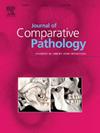Special AT-rich sequence-binding protein 2 immunohistochemistry in the diagnosis of osteosarcoma in dogs
IF 0.8
4区 农林科学
Q4 PATHOLOGY
引用次数: 0
Abstract
Malignant osteoblasts can have markedly pleomorphic phenotypes and variable amounts of tumour-associated matrix, complicating the ability of pathologists to accurately differentiate osteosarcoma (OSA) from other types of neoplasms using only histopathology. Current immunohistochemical markers for animals have limited sensitivity and specificity in identifying OSA or produce inconsistent results. Immunohistochemistry (IHC) for special AT-rich sequence-binding protein 2 (SATB2) has been used in human medicine to aid in identification of normal and neoplastic osteoblasts, and the objective of this study was to determine whether this marker could also be useful for the diagnosis of canine OSA. Initially, SATB2 IHC was performed on eight samples from cases of well-differentiated canine OSA and on other tumour types for which OSA is a differential diagnosis, as well as on normal tissues, to assess sensitivity and cross-reactivity. Following confirmation that SATB2 is immunoreactive for normal and neoplastic canine osteoblasts and negative in other non-osseous mesenchymal cell types and organs, SATB2 IHC was tested on 123 cases of poorly differentiated malignant neoplasms as part of a panel with other immunohistochemical markers, as appropriate, based on histomorphology and differential diagnoses. The conclusion is that SATB2 IHC is a sensitive and specific marker for identifying canine OSA when used in a panel with other immunohistochemical markers and in conjunction with supportive clinical history.
特殊富AT序列结合蛋白2免疫组化在犬骨肉瘤诊断中的应用。
恶性成骨细胞可能具有明显的多形性表型和不同数量的肿瘤相关基质,这使得病理学家仅通过组织病理学准确区分骨肉瘤(OSA)和其他类型肿瘤的能力变得更加复杂。目前用于动物的免疫组化标记物在鉴别 OSA 方面的灵敏度和特异性有限,或者产生的结果不一致。特殊富AT序列结合蛋白2(SATB2)的免疫组化(IHC)已在人类医学中用于帮助鉴别正常和肿瘤性成骨细胞,本研究的目的是确定该标记物是否也可用于犬OSA的诊断。首先,对来自分化良好的犬 OSA 病例、OSA 作为鉴别诊断的其他肿瘤类型以及正常组织的八个样本进行了 SATB2 IHC 检测,以评估敏感性和交叉反应性。在确认 SATB2 对正常和肿瘤性犬成骨细胞有免疫反应,而对其他非骨质间充质细胞类型和器官呈阴性反应后,对 123 例分化不良的恶性肿瘤进行了 SATB2 IHC 检测,并根据组织形态学和鉴别诊断结果,酌情将其与其他免疫组化标记物一起作为检测组的一部分。结论是,SATB2 IHC 与其他免疫组化标记物一起使用,并结合辅助性临床病史,是鉴别犬 OSA 的敏感而特异的标记物。
本文章由计算机程序翻译,如有差异,请以英文原文为准。
求助全文
约1分钟内获得全文
求助全文
来源期刊
CiteScore
1.60
自引率
0.00%
发文量
208
审稿时长
50 days
期刊介绍:
The Journal of Comparative Pathology is an International, English language, peer-reviewed journal which publishes full length articles, short papers and review articles of high scientific quality on all aspects of the pathology of the diseases of domesticated and other vertebrate animals.
Articles on human diseases are also included if they present features of special interest when viewed against the general background of vertebrate pathology.

 求助内容:
求助内容: 应助结果提醒方式:
应助结果提醒方式:


